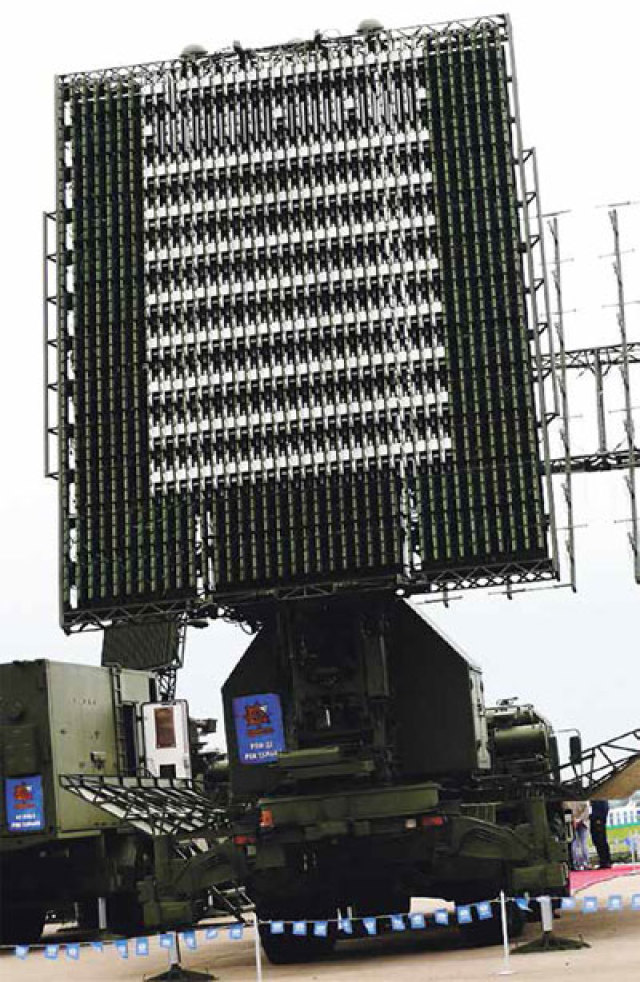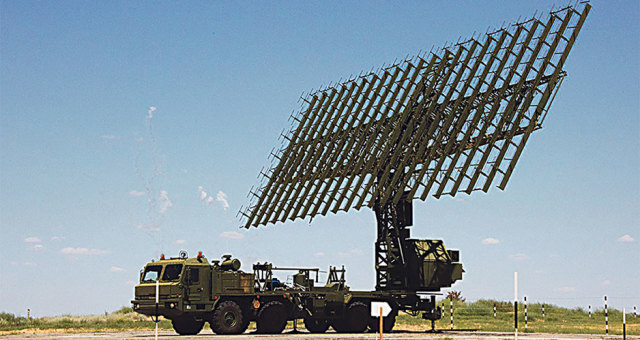The Nebo-UM radar is capable of detecting hypersonic aircraft manufactured using Stealth technology
On December 14, 2020, a new Nebo-UM radar station entered combat duty in the Rostov region. It will significantly increase the capabilities of the Russian aerospace forces to detect various air targets, including low-flying ones with a small reflective surface, which is especially important in light of recent events in Nagorno-Karabakh and Syria. We are talking about timely detection and reflection of cruise missile strikes, unmanned aerial vehicles. With the development of technology, they are becoming more and more dangerous for combat units, weapons and military equipment, and command posts of troops. What is the new radar station and why is it located in the Rostov region?
Three-coordinate radar station of medium and high altitudes "Nebo-UM" is a further development of the "Nebo-U" radar systems with a modified composition of equipment made on a new element base.
The station is capable of finding and tracking both aerodynamic (aircraft, helicopters, cruise missiles, etc.) and ballistic (missile warheads) targets, determining their nationality, and transmitting information to the command post or anti-aircraft systems. In addition, it can locate the sources and location of interference, automatically transmit their coordinates to combat calculations for further destruction.
The Nebo-UM radar is designed to detect, measure coordinates and track various aircraft at a range of up to 600 kilometers, including small-sized, hypersonic, ballistic and low-visibility ones made using Stealth technologies.
All this, figuratively speaking, will significantly improve the vision of the troops of the southern military district and the Russian aerospace forces as a whole.
Good pedigree
Some time ago, two radio engineering regiments of the Western military district, stationed in the Leningrad region and Karelia, already received the Nebo-UM radar. This means that the North-Western direction of the Russian Federation is already covered from the penetration of detailed dangerous targets and provocations. Recall that the notorious Mathias rust, who made so much noise, entered the airspace of the USSR at low altitude (light-engine aircraft "Tsesna") from this direction and flew on the route Helsinki – Leningrad – Moscow. Who knows if our Western "partners" are preparing a new similar provocation to once again test the vigilance of the air defense of the now Russian Federation from various directions.
"Today, work is also underway on ring HEADLIGHTS with an all-angle view of the airspace. With the development of high-speed hypersonic weapons, this direction has become particularly relevant ”
Recently, on the southern borders of Russia, there has been a particularly high activity of tactical and strategic reconnaissance aircraft of the US air force, based on Turkish and Saudi air bases. More recently, during NATO exercises, b-52 strategic bombers in The black sea area went to combat lines to simulate missile launches of cruise missiles at strategic objects of Russia. Therefore, this direction is now as rocket-dangerous as the Northern one.
It is important that the Nebo-UM radar has high mobility and can be deployed on a variety of theater systems. On December 14, in particular, the calculations of the southern military DISTRICT demonstrated exactly this ability of the complex. The units made a cross-country March with a new complex, deployed a radar station. After that, the combat work of the station's calculations began to detect low-flying small-sized targets, search, identification, tracking and data transmission to the KP.
By the way, the new station has what is called a good pedigree. Nebo radar is a family of Russian radar stations in the meter wave range. The developer is the Nizhny Novgorod research Institute of radio engineering (NNIIRT). It was produced in versions for both air defense and Ground forces. In the air defense version, the antenna system is more complex, the installation and dismantling time is much longer, and the station's capabilities are wider. And when delivered to the Ground forces, the antenna system was simplified to increase mobility. There are other modifications. How do they differ from each other?
Radar 55ZH6 meter wave range for air defense Forces – three-coordinate. Development of NNIIRT 1982-1987. It was delivered to the USSR armed forces since 1986. The range of detection of a fighter-type target was carried out at an altitude of up to 20 kilometers and a range of up to 400 kilometers.
At the station for Ground forces, the range of detection of a fighter-type target at an altitude of 27 kilometers is 350 kilometers, at an altitude of 500 meters-up to 60 kilometers. The kit includes a radar interrogator of the "friend-foe" system with its own antenna. To obtain the third coordinate (target height), the station can be paired with a radio altimeter. Currently, it is in service with a number of units and divisions of the SV. Deployment/collapse time-no more than 30 minutes. There is also an export version ("Sky-UE" 55ZH6UE). In particular, the "Sky-IED" is in service with Iran.
"Sky-U" 55ZH6U-upgraded version of the radar 55ZH6 "Sky". It has been supplied to the Russian Armed forces since 1995. In 2011, work began on its modernization (ROC "Niobium", 55ZH6UM). In 2016, it was put into production. It is produced by the Nizhny Novgorod television plant. In may 2016, it entered service with the troops of the Western military district. In the summer of 2017 – in the CVO. Of course, its characteristics are much better.
As for the "Sky-MIND", then, as already noted, this is a new generation station. Although purely formally represents the further modernization of the radar 55ZH6U "Sky-U", but created on a new element base. It allows you to detect aerodynamic and ballistic targets, sources of electronic interference at an altitude of up to 80 kilometers and within a radius of up to 600 kilometers. Since 2017, it has been entering the army as part of the state defense order. The Ministry of defense has signed a contract for the supply of these stations with the manufacturer-the Nizhny Novgorod research Institute of radio engineering.
Impenetrable ring
The Ministry of defense attaches great importance to these supplies. The fact is that long-range radar detection of promising tactical fighters of the fifth generation and their subtle missile weapons is considered a fundamental basis for building reliable defensive tactics in modern warfare, both ground and air components of the air force (including military air defense) and naval ship strike groups. This is the most important indicator of the equipment of troops with modern means of air defense. Since the end of the twentieth century, the technological confrontation of advanced countries on the development of mobile high-potential radar systems AWACS Began. As well as highly sensitive complexes for electronic intelligence and passive location based on active and passive HEADLIGHTS. The loser of this fight will be in a very difficult position on the battlefield.

Photo: bastion-karpenko.ru
Photo: bastion-karpenko. GIS today, work is also underway on ring HEADLIGHTS (stations with phased array antennas) with an all-angle view of the airspace. With the development of high-speed hypersonic weapons, this direction has become particularly relevant, since among such targets may be combat units of ballistic missiles of different classes, other high-precision weapons.
Let us explain that the Russian army is armed with stations of the meter, decimeter and centimeter range. But not all of them are interfaced with each other, some have excellent tasks. For example, the "Voronezh-M" and "Voronezh-DM" type SPRn radars are capable of detecting and tracking VTO aerospace elements with an effective reflecting surface of 0.1 m2 at ranges from three to five thousand kilometers. These are stationary radars, with which stations of the "Sky-MIND" type will interact. Together, they will create an impenetrable ring of defense, will be used for targeting long-range air defense systems S-300PM1, S-400 "Triumph", S-300V4.
After the station "Voronezh-M" in the village of lekhtusi, Leningrad region, was put on combat duty in February 2012, the East Kazakhstan region has already received 10 such radars. The last to enter service were the Voronezh-DM radar stations in Yeniseisk, Barnaul, and the Voronezh-VP station in Orsk. This network has created a fairly dense radar field around Russia in all missile-dangerous air directions at distances of 4,200-6,000 kilometers. The record capacity of each such radar is up to 500 targets, which will allow you to maintain control over the combat situation even at the time of a massive strike by means of an enemy aerospace attack. Before that, eight new and upgraded radar stations, including Nebo-UT, Podlet-K1, RLS39N6 and Desna, were put into service in the southern military DISTRICT. The Terek radar station, as well as a number of altimeters, underwent a deep modernization.
The question may arise: are there too many different modifications of the radar we are trying to introduce into the troops, do they duplicate each other? The fact is that despite the numerous advantages of many means of radio and electronic intelligence, they are able to issue a warning time before the approach of small-sized hypersonic elements of high-precision weapons (speed-6-7 M) in 1.5–2 minutes. Which, of course, is extremely insufficient to bring the anti-aircraft missile brigades of the VKS and divisions of the military air defense into combat readiness. Additional mobile radar devices with higher energy qualities are needed, which would allow notifying the anti-missile link in a certain area of the theater of operations about the approach of such hypersonic targets at least five minutes before their approach.
In this respect, we repeat, there is no equal to the Nebo-M and Nebo-UM radar complexes, which combine the qualities of the SPRn, AWACS, and target designation radar for anti-aircraft missile units. For example, the Nebo-M complex is a record holder both in versatility and in the parameters of early target designation (2-5 minutes) for the s-300V4 and s-400 Triumph anti-aircraft missile systems linked to the East Kazakhstan region system. And the Nebo-UM radar will strengthen this link.
All of the above once again confirms the simple truth: after the appearance of new means of attack, the means of parrying them are inevitably born. This is the logic of the unity and struggle of opposites, the opposition of defense systems to attack systems. As they say, a classic of the genre. Another thing is that we should never be led to provocations of the enemy, to get involved in an arms race. As it happened in the USSR after the so-called SOY program announced by the United States, which then ended in a complete zilch. And our country spent scarce resources on research that was excessive at that time.
We've been through all this before during the cold war. Our politicians and military should not be let down by a sense of proportionality this time. After all, we already know how mindless saber rattling can end. For the Soviet Union, it ended with empty store shelves, the collapse of the country. It seems that we have already received a vaccination against this – once and for all.
Oleg Falichev
The newspaper "Military-industrial courier", published in issue No. 49 (862) for December 22, 2020

